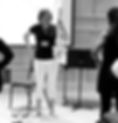

THE COURSE:
WHAT EVERY MUSICIAN NEEDS TO KNOW ABOUT THE BODY
Helping Prevent Performance-Related Injuries, Unleashing Artistic Expression
Learn to play with efficient and dynamic movement using the principles of Body Mapping
Increase awareness of your movement habits
Learn how common mismappings can inhibit expressive movement and technical facility

In this course, musicians learn how to correct and refine the body map to produce efficient, coordinated, and effective movement. Body Mapping not only helps musicians avoid injury, it also enhances musicians’ technique.


THIS COURSE TEACHES
1.
2.
3.
4.
5.
6.
An Introduction to Body Mapping: learn about how the way you think about your Body Map changes your movement
Balance: understand our six places of balance to find freedom and dynamic buoyancy in movement
Arms: map the whole arm and its relationship to the torso
Breathing: accurately map breathing structures for better breaths
Legs: move with a greater understanding of weight delivery
Body Mapping Masterclass: how to cooperate actively with your anatomy, in macro and micro movement while singing or playing your instrument
Who are we?
Taught in universities, conservatories, and private studios worldwide, the What Every Musician Needs to Know About the BodyⓇ course helps prevent musicians’ injuries through increasing self-awareness, learning practical anatomy, and practicing efficient and dynamic movement. Body Mapping Educators are licensed through the Association for Body Mapping Education, a not-for-profit organization.
What Every Musician Needs to Know About the BodyⓇ is designed to set each participant on a path of self-evaluation and change, in order that they may become and remain free of injury and pain through a lifetime of performing.
Here’s what others have asked:
Is the What Every Musician course taught in one day?
The six-hour course can be taught in one day or over several days depending on what works best for your organization.
The information taught in this course reminds me of my Alexander Technique lessons. How is Body Mapping different from Alexander Technique?
While a Body Mapping lesson and an Alexander lesson might contain similar information, a Body Mapping teacher would do no hands-on teaching, relying on changes in the student’s body map to achieve improved movement. Changes in student’s body maps would be brought about by use of verbal coaching and extensive use of visual aids like anatomical models, and by extensive demonstration, that is, the teacher is modeling the desired movement. The Body Mapping teacher then carefully observes the student’s movement and gives active feedback about the changes in movement that occur as changes are made in the body map.
The Alexander Technique, by contrast, generally makes extensive use of hands-on instruction and is often characterized as using a process called constructive conscious control, in which a maladaptive postural pattern is “inhibited” while a more constructive pattern is learned. This learning may occur during “lying down work,” “chair work,” “monkey,” “whispered ahhh,” and other procedures traditionally used in teaching the Technique.
What is the Alexander Technique?
The Alexander Technique is a simple and practical method for improving ease and freedom of movement, balance, support, flexibility, and coordination. It enhances performance and is therefore a valued tool for musicians. Practice of the Technique refines and heightens kinesthetic sensitivity, offering the performer a control which is fluid and lively rather than rigid. It provides a means whereby the use of a part — a voice or an arm or a leg — is improved by improving the use of the whole body, indeed, the whole self. With the Alexander Technique, these benefits are accomplished by the application in one’s own experience of what Frederick (F. M.) Alexander called constructive conscious control. Constructive conscious control is a process of self-observation and self-analysis, wherein one becomes intimately knowledgeable about one’s own habits so that one can suspend habitual muscular tightening (sometimes called downward pull), where it exists, and gradually consciously replace it with constructive behavior.
I have more questions, how can I get in touch?
Since this course is taught only by Licensed Body Mapping Educators, please visit our find a teacher section to find an LBME near you and contact them directly. They will provide you with more information on their processes and pricing for teaching this course.
Have more questions about Body Mapping?
Click here to visit our FAQs page.






